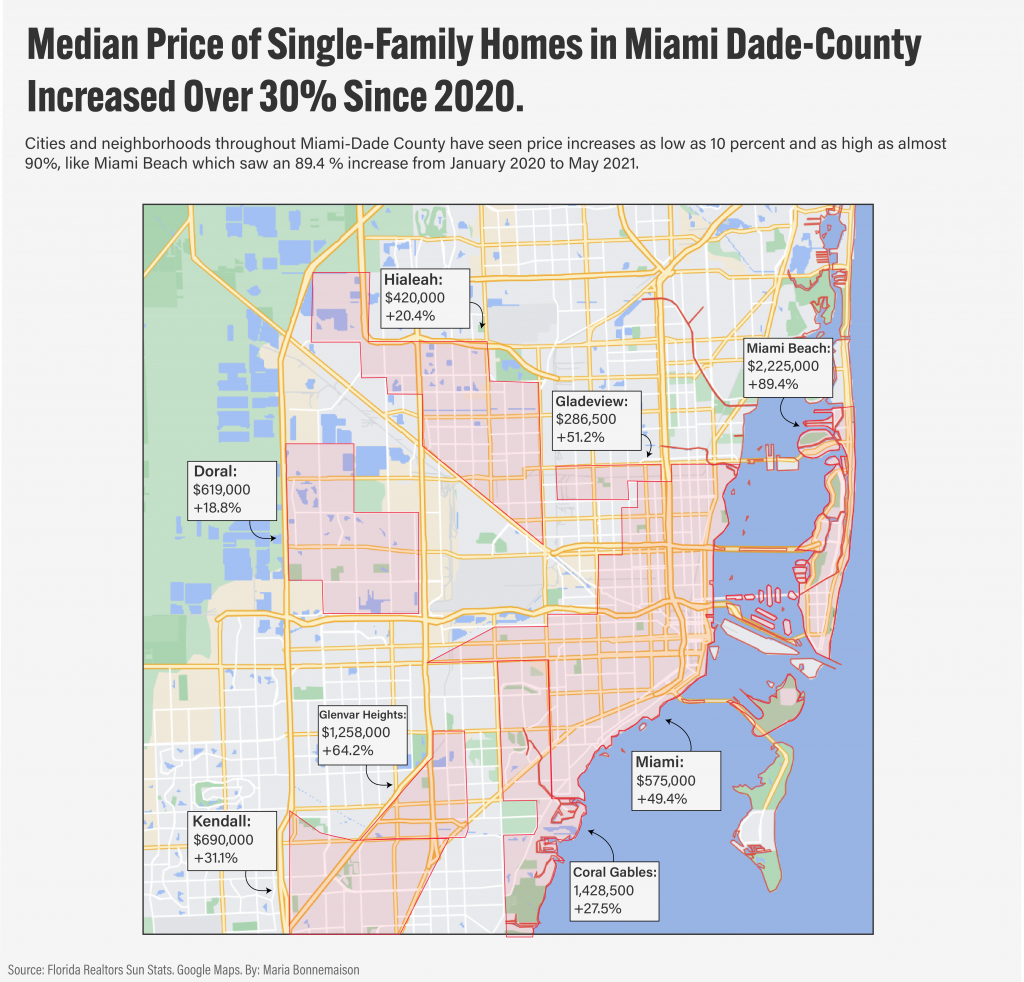Gema Parra lives in a small two-bedroom apartment in Miami with her husband and two children– a 4-year-old daughter and a 3-month-old son. The 33-year-old working mother is a project engineer who considers herself financially stable and organized.
But she now worries about owning a house.
“We need to buy a home to stabilize the future of our children’s lives,” she says. “The biggest difficulty for us now is the market. We live in an excessively expensive city for housing.”
Parra is one of the thousands of South Floridian prospective homebuyers who have been caught by the whipsaw of post-pandemic prices. Miami-Dade County saw a 33% increase in the median cost of single-family homes from $375,000 in January 2020 to $500,000 in May 2021. Broward County saw a 23% increase, and Collier county jumped 38% — the largest increase in South Florida.
“South Florida does have a very significant housing affordability issue. A lot of people who live here pay more than one-third of their income for housing,” said Mark Thibodeau, a professor at Florida International University’s Tibor and Sheila Hollo School of Real Estate. “There are not necessarily good ways to purchase homes [even] if you can’t afford it, there’s no way around that.”
In February 2020 the U.S. declared a health emergency after the emergence of COVID-19. That March, the Federal Reserve cut interest rates to zero, the lowest they have been since the 2008 financial crisis, in order to stimulate economic growth.
What followed was a significant appreciation of house prices nationwide as potential homeowners scrambled to buy in a market that was not ready to meet the demand.
Many factors contributed to the rapid increase of homeownership at the start of the pandemic: not only mortgage rates at an all-time low, but people working from home, and families moving away from cities to bigger homes in the suburbs. The main aspect at play was basic supply and demand, says Thibodeau.
“What we have seen is a disruption to supply chains, which increases the cost of construction and raw materials,” he said. “Construction at the beginning of the pandemic came to a standstill, it took longer, or it became more expensive. As a result, there has been a lag in the supply of new housing.”
William Hardin, Interim Dean of FIU’s School of Real Estate, explains this phenomenon that is rooted in the Financial crisis of 2008.
“The typical homebuilder in the U.S is relatively small,” said Hardin. “The typical home builder builds less than 10 homes a year. After the recession of 2008, the industry that creates single-family homes was devastated. Since then we have undersupplied the market by hundreds of thousands of housing units.”
Adds Thibodeau: “We saw savings rates go up significantly at the beginning of the pandemic when people weren’t going out to eat at restaurants and were getting stimulus checks from the Federal government,” said Thibodeau. “There has been some migration from New York City to South Florida that also exacerbates these market dynamics that are increasing demand while supply is constrained. All of these things led to the growth and appreciation in house prices.”
The pandemic most negatively impacted service industry folks, people of disproportionately lower incomes, and renters.
Venezuelan immigrant Alcuz Oñate, is a renter looking to purchase his first home. As an immigrant, he doesn’t qualify for many mortgage loans, but he might get help from the Federal Housing Administration as a first-time buyer. However, this type of loan has strict requirements for qualification, which become increasingly difficult to meet when there is very little supply on the market.
“Our main option right now is getting an FHA loan, but the only available properties don’t meet the loan requirements, and there aren’t sufficient options on the market to meet the qualifications or properties we can also afford,” said Onate. “The only alternative now is to rent.”

South Florida realtor Carlos Villalon, said the current state of the market is unprecedented. It has become more difficult than ever for locals to compete with out-of-state buyers who decided to move to Florida due to its nice weather, lower taxes, and cheaper housing.
“Most realtors never imagined the market would be where it is now,” said Villalon. “Before the pandemic, the market was slow, instead we thought prices would lower. But now the market is hot. It’s difficult for local service workers like teachers, lawyers, and firefighters to compete with people coming from other states that were paying double what they would pay for a home in Florida,” he said. “These people usually come with offers above the asking price and they pay in cash, whereas locals need to apply for mortgage loans.”
What’s next for the market largely depends on where you are shopping. Some areas where the rapid increase of prices was out of the norm might see major corrections. But in the case of South Florida, the pandemic seems to have accelerated a motion that was already running.
“In South Florida, the supply constraints are real,” said Hardin. “So I don’t see a collapse.”
Gema Parra feels strongly about the importance of owning the right home for her family, but with the current volatility of the market, she will have to put off owning a home for longer until the conditions are right for her family.
“The challenge is finding a home with a combination of all of the things we need,” says Parra. “It’s hard to find a house with enough space, in a safe area with access to good public schools, and with reasonable prices, we can afford.”
“We had the goal of buying a home in the first quarter of next year but it’s very likely we won’t be able to,” she says. “However, we’re still optimistic, we just need to wait for the prices to stabilize. We know the prices won’t go down, but we hope they will at least slow down enough for us to make a plan.”


































